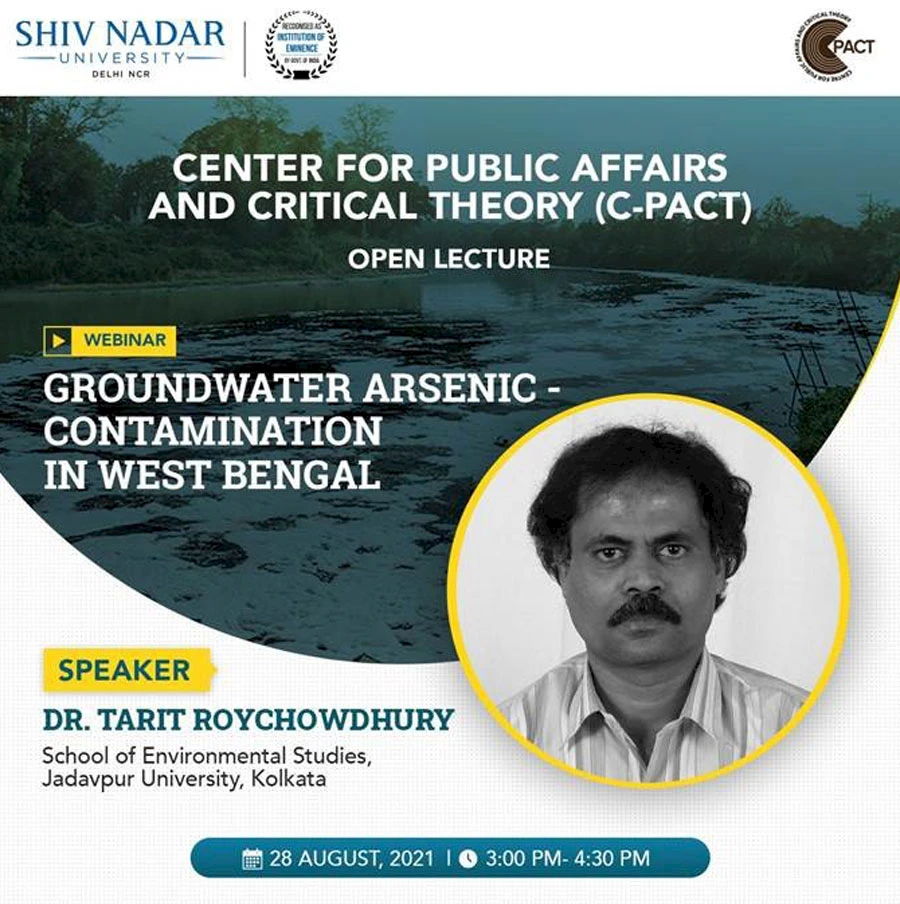Center for Public Affairs and Critical Theory (C-PACT) Organizing a Webinar on 'Groundwater arsenic-contamination in West Bengal
The Center for Public Affairs and Critical Theory (C-PACT) invites you to a talk titled 'Groundwater arsenic-contamination in West Bengal, India with special reference to its status, magnitude, distribution, health effects, food chain contamination, and remedial measurements' on 28 August 2021 at 3:00 PM. The talk will be delivered by Dr. Tarit Roychowdhury, School of Environmental Studies, Jadavpur University, Kolkata.
Natural groundwater arsenic contamination and the resulting toxic effects have become one of the staggering challenges to human health in modern times, with large parts of the Ganga-Meghna-Brahmaputra plain of India with an area of 569,749 km2 and population over 500 million has been exposed to this devastating calamity. The calamity in these places, particularly in Bengal delta, with over 100 million people living in zones has assumed gargantuan proportions as arsenic levels in drinking water has overshot far above the guidelines set by World Health Organization at 10 μg/L. Arsenic concentration in groundwater initially increases up to a certain depth (approximately 40 m below ground level), then decreases with increase of depth. Moreover, arsenic concentrations in many tube wells had been increased 5-20 folds within a span of 3-7 years. The presence of deep tube well in the rural areas has somewhat ensured the arsenic-contamination problem in groundwater, but it varies on hydro-geographical conditions. Furthermore, what is worrisome is that arsenic-contaminated groundwater is increasingly being used to irrigate the fields. Thus, arsenic has begun to seep into crops and food chain which could trigger a large scale environmental tragedy, fatally affecting future generations.
Arsenic is a naturally occurring element and arsenic levels in foods generally reflect its natural accumulation from the environment. It is very common knowledge that the arsenic-contaminated groundwater, which is mainly used for drinking, is a major route of arsenic exposure but when the same water is being used for agricultural purposes, mainly for the ‘boro’ cultivation of paddy, the problem of arsenic accumulation aggravates. Arsenic accumulation in paddy plants at different phases of pre-monsoon cultivation has been further extensively studied. Arsenic is translocated from root to aerial parts in descending order. Leaf, stem, root, root soil and surface soil showed a similar trend in their change of arsenic concentration throughout the cultivation period. Arsenic concentration was highest in vegetative phase; sharply declined in reproductive phase; followed by moderate increase in ripening phase. Thus, soil arsenic concentration increases in the final phase of cultivation which in turn contributes to increased concentration in plant parts. However, during monsoonal cultivation, the synergistic effect of groundwater and rainwater makes a diffused approach to the nature of arsenic flow in plants, which provides least arsenic enriched grain irrespective of the variety of cultivar and area of cultivation, compared to the pre-monsoonal grain and much safer for consumption with respect to arsenic.
Mitigation technologies need to be addressed for reduction of arsenic in soil-plant system to restrict its entry in rice grain. Use of synthesized nanoparticle(s) like Fe-and Si-nanoparticles and other agrochemicals (organic and minerals) in soil can be experimented to reduce the arsenic flow from root to shoot and investigate the effect on antioxidant activities under arsenic stress condition in paddy and other vegetable plants. Hydro-priming of rice seed with potassium humate for germination enhancement, seedling growth promotion and better antioxidant defense system under arsenic stress can be investigated. The overall goal is to address the problem of arsenic contamination in food chain, especially the rice grain which is a staple food suggesting a plausible guideline in preparing management mitigation plan, which could be adaptive for the society.

Share this: